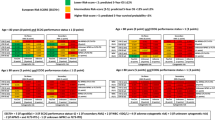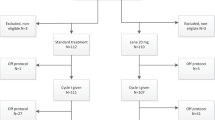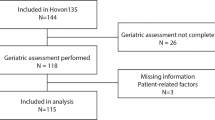Abstract
The treatment of older patients with acute myeloid leukemia is a difficult challenge. Older adults are more likely to have comorbidities that can limit treatment options, the disease tends to be more aggressive biologically and outcomes are worse than those in younger patients. Deciding which older patients would benefit from intensive chemotherapy is difficult, and efforts are underway to improve existing risk-assessment tools. Treatment should be individualized and may include standard chemotherapy for those patients who have none or at most one adverse factor, or investigational agents for those presenting with multiple poor-risk features. Low-intensity therapies are recommended for those patients who are deemed too frail to tolerate myelosuppressive regimens.
This is a preview of subscription content, access via your institution
Access options
Subscribe to this journal
We are sorry, but there is no personal subscription option available for your country.
Buy this article
- Purchase on Springer Link
- Instant access to full article PDF
Prices may be subject to local taxes which are calculated during checkout
Similar content being viewed by others
References
Burnett A, Wetzler M, Lowenberg B . Therapeutic advances in acute myeloid leukemia. J Clin Oncol 2011; 29: 487–494.
McClune BL, Weisdorf DJ, Pedersen TL, Tunes da Silva G, Tallman MS, Sierra J et al. Effect of age on outcome of reduced-intensity hematopoietic cell transplantation for older patients with acute myeloid leukemia in first complete remission or with myelodysplastic syndrome. J Clin Oncol 2010; 28: 1878–1887.
Wheatley K, Brookes CL, Howman AJ, Goldstone AH, Milligan DW, Prentice AG et al. Prognostic factor analysis of the survival of elderly patients with AML in the MRC AML11 and LRF AML14 trials. Br J Haematol 2009; 145: 598–605.
Kantarjian H, Ravandi F, O’Brien S, Cortes J, Faderl S, Garcia-Manero G et al. Intensive chemotherapy does not benefit most older patients (age 70 years or older) with acute myeloid leukemia. Blood 2010; 116: 4422–4429.
Burnett AK, Milligan D, Prentice AG, Goldstone AH, McMullin MF, Hills RK et al. A comparison of low-dose cytarabine and hydroxyurea with or without all-trans retinoic acid for acute myeloid leukemia and high-risk myelodysplastic syndrome in patients not considered fit for intensive treatment. Cancer 2007; 109: 1114–1124.
Author information
Authors and Affiliations
Corresponding author
Ethics declarations
Competing interests
The author declares no conflict of interest.
Additional information
This article was published as part of a supplement that was supported by Novartis, MSD Italia, Roche, Celgene, GlaxoSmithKline, Sanofi, Gilead, Adienne, Italfarmaco, Pierre Fabre Pharmaceuticals with an unrestricted educational contribution to AREO—Associazione Ricerche Emato-Oncologiche (Genoa) and AMS—Associazione Malattie del Sangue (Milan) for the purpose of advancing research in acute and chronic leukemia.
Rights and permissions
About this article
Cite this article
Amadori, S. Treating older patients with AML. Leukemia Suppl 1 (Suppl 2), S16–S17 (2012). https://doi.org/10.1038/leusup.2012.11
Published:
Issue Date:
DOI: https://doi.org/10.1038/leusup.2012.11
Keywords
This article is cited by
-
Comorbidity, Physical Function, and Quality of Life in Older Adults with Acute Myeloid Leukemia
Current Geriatrics Reports (2017)



